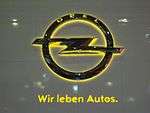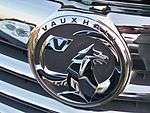Opel Vectra
| Opel Vectra | |
|---|---|
|
Opel Vectra C (facelift) | |
| Overview | |
| Manufacturer | Opel (General Motors) |
| Also called |
Vauxhall Vectra Holden Vectra Chevrolet Vectra |
| Production | 1988–2008 |
| Body and chassis | |
| Class | Mid-size car / Large family car (D-segment) |
| Layout | Transverse front engine, front-wheel-drive/four-wheel-drive |
| Chronology | |
| Predecessor | Opel Ascona |
| Successor | Opel Insignia |
The Opel Vectra is a large family car that was engineered and produced by the German automaker Opel. In the United Kingdom, the car was sold under the Vauxhall marque as the Vauxhall Cavalier and later as the Vauxhall Vectra, from 1995 onwards. It has also been sold by Holden in Australasia as Holden Vectra, and by Chevrolet in Latin America as the Chevrolet Vectra.
The Vectra was introduced in October 1988 as a replacement to the Opel Ascona, and itself was replaced in November 2008 by the Opel Insignia, the nameplate spanning twenty one years and three generations of car.
Vectra A (1988–1995)
| Vectra A | |
|---|---|
.jpg) | |
| Overview | |
| Also called |
Chevrolet Vectra Holden Vectra (New Zealand) Vauxhall Cavalier |
| Production | 1988–1995 |
| Assembly |
Belgium: Antwerp Brazil: São Caetano do Sul (1993–1996) Egypt: 6th of October City (GME) (1994–1996)[1] England: Luton Germany: Eisenach Germany: Rüsselsheim Venezuela: Caracas |
| Designer | Wayne Cherry |
| Body and chassis | |
| Body style |
4-door notchback saloon 5-door hatchback |
| Platform | GM2900 platform |
| Related | Opel Calibra |
| Powertrain | |
| Engine |
|
| Transmission |
5-speed manual (F10/5, F13/5, F16/5, F20/5) 6-speed Getrag manual (F28/6) 4-speed automatic |
| Dimensions | |
| Wheelbase | 2,600 mm (102.4 in) |
| Length |
4,430 mm (174.4 in) (saloon) 4,350 mm (171.3 in) (hatch) |
| Width | 1,700 mm (66.9 in) |
| Height | 1,400 mm (55.1 in) |
| Curb weight | 997–1,199 kg (2,198–2,643 lb) (4-cyl petrols) |
The first generation Vectra, known as the Vectra A, was introduced in October 1988, as a four-door notchback saloon and a five-door hatchback, replacing the Opel Ascona C. A coupé based on the Vectra, called the Calibra, was introduced the following year. Both cars were designed by the Opel design chief at the time, Wayne Cherry. Vauxhall Motors, the British GM subsidiary that shared most of its models with Opel, did not use the "Vectra" model name until Vauxhall introduced the name into the United Kingdom in August 1995. The 1989 Vectra came in Base, LS, GL, GLS, CD, and GT models, its sister model was the third generation Cavalier.
Engines ranged initially from a 75 PS (55 kW) 1.4 L to a 130 PS (96 kW) 2.0 L Family II. With the introduction of Euro I emissions regulations, the base model was replaced by a 1.6 L with the same output, while the top of the line was given to a 16 valve version of the 2.0 L engine, which powered the GT (GSI) version, and had 150 PS (110 kW).
Two four wheel drive versions were added to the lineup in 1990, and in 1993, the car received a limited edition turbocharged version, with 204 PS (150 kW). The 1.4 litre engine was not available in all markets, and even then, it was only available in basic trims (Base/L in United Kingdom, LS/GL in Europe). A 2.5 L V6 engine appeared towards the later stages of the Vectra's life, developing 170 PS (125 kW), turning the car into a relaxed motorway cruiser rather than giving it sporty pretensions.
There were a choice of two diesel engines; one was an Isuzu 1.7 L 4EE1 inline-four unit, in both naturally aspirated and turbocharged form (1,686 cc), this one capable of achieving 82 PS (60 kW), and an Opel designed 1.7 "low blow" turbodiesel (1,699 cc), and naturally aspirated diesel unit, delivering up to 68 PS (50 kW; 67 hp).
The front suspension was fully independent, with MacPherson struts, pressed steel lower control arms, and an anti-roll bar. The front suspension, together with the major mechanicals (engine and transmission) is remotely mounted on a front subframe. On front wheel drive models, the rear suspension is semi independent, consisting of a torsion beam axle linked to trailing arms, with double conical coil springs and direct acting telescopic hydraulic shock absorbers, with certain models also having an anti roll bar.
On the four wheel drive GSi, 4x4 and Turbo models, the rear suspension is a subframe mounted fully independent design, with semi trailing arms, double conical coil springs, direct acting gas assisted telescopic shock absorbers, and an anti roll bar. Steering gear is a rack and pinion type (manual or power assisted, depending on model), mounted on the bulkhead (firewall), with a telescopically deformable steering column.
The Vectra also received a refresh in September 1992.[2] The range received new front grilles and a black plastic strip above the rear taillamps, along with an upgrade to the structure for improved crashworthiness. Airbags became available onwards from 1993. The Vectra gave birth to a coupé version, the Opel Calibra, which shared the Vectra's platform, gearbox and several engines.
In New Zealand, the Vectra A was offered initially as an Opel between 1989 and 1994, but it wore Holden badges between 1994 and 1996 until the introduction of the Vectra B. It was not sold in Australia, where Holden instead offered a rebadged Toyota Camry called Apollo until 1997.
In Brazil, the Chevrolet badged Vectra A was not introduced until 1993, when it replaced the Chevrolet Monza, a restyled version of the Ascona C. The first Brazilian model had two engine options: o 2.0 8 valve, for the GLS and CD versions and the remarkable 2.0 16 valve with 150 hp imported from Germany, the later only available for the GSI version. The release of the second generation of the Chevrolet Vectra in Brazil happened at the same time of the IndyCar series in Brazil, GM made a deal to use the Vectra as a Medical and Safety car for the race.
The second generation (or Vectra B), came with the already available 2.0 8 valve engine on the GL and GLS versions and a national version of the previously 2.0 16 valve for the CD version. In 1998, GM introduced the new 2.2 8 valve engine for the GL and GLS, and the 2.2 16 valve with 138 hp and 207Nm for the CD version.
In Egypt, the Opel Vectra A was not introduced until 1994 through GM Egypt Dealerships, and started production in the end of 1994 by GM Egypt through the beginning of 1996, with a range of 1.6 GL, 2.0 GL trim and 2.0 GLS trim and only Saloon body style boosting strong sales during this short run. This was similar to the Opel Kadett.
In 1994, the European Turbo 4x4 version of the Vectra was used in Formula One as its Safety Car. Most notably, it was deployed at the San Marino Grand Prix.
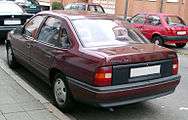 Pre facelift Opel Vectra A saloon
Pre facelift Opel Vectra A saloon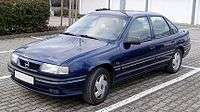 Facelifted Opel Vectra A saloon
Facelifted Opel Vectra A saloon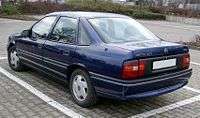 Facelifted Opel Vectra A saloon
Facelifted Opel Vectra A saloon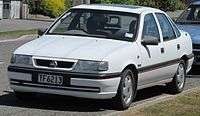 Holden Vectra 2.0 GLS sedan (New Zealand)
Holden Vectra 2.0 GLS sedan (New Zealand)_(14961906968).jpg) Interior
Interior
Engines
| Engine model | Displ. | Power | Torque | Fueling system | Valvetrain | Top speed |
|---|---|---|---|---|---|---|
| 14NV | 1.4 L | 55 kW (75 PS; 74 hp) @ 5600 rpm | 108 N⋅m (80 lb⋅ft) @ 3000 rpm | Carburettor | SOHC | 176 km/h (109 mph) |
| 16SV | 1.6 L | 60 kW (82 PS; 80 hp) @ 5200 rpm | 130 N⋅m (96 lb⋅ft) @ 2600 rpm | Carburettor | SOHC | 178 km/h (111 mph) |
| C16NZ(2) | 1.6 L | 55 kW (75 PS; 74 hp) @ 5200 rpm | 127 N⋅m (94 lb⋅ft) @ 2600 rpm | SPFI | SOHC | 176 km/h (109 mph) |
| E16NZ | 1.6 L | 55 kW (75 PS; 74 hp) @ 5200 rpm | 125 N⋅m (92 lb⋅ft) @ 2600 rpm | SPFI | SOHC | 176 km/h (109 mph) |
| X16SZR | 1.6 L | 52 kW (71 PS; 70 hp) @ 5000 rpm | 128 N⋅m (94 lb⋅ft) @ 2800 rpm | SPFI | SOHC | 176 km/h (109 mph) |
| 18SV | 1.8 L | 66 kW (90 PS; 89 hp) @ 5400 rpm | 148 N⋅m (109 lb⋅ft) @ 2800 rpm | Carburettor | SOHC | 183 km/h (114 mph) |
| E18NVR | 1.8 L | 65 kW (88 PS; 87 hp) @ 5400 rpm | 143 N⋅m (105 lb⋅ft) @ 2800 rpm | Carburettor | SOHC | 182 km/h (113 mph) |
| C18NZ | 1.8 L | 66 kW (90 PS; 89 hp) @ 5400 rpm | 145 N⋅m (107 lb⋅ft) @ 3000 rpm | SPFI | SOHC | 183 km/h (114 mph) |
| C20NEF | 2.0 L | 74 kW (101 PS; 99 hp) @ 5200 rpm | 158 N⋅m (117 lb⋅ft) @ 2600 rpm | MPFI | SOHC | |
| 20NE | 2.0 L | 85 kW (116 PS; 114 hp) @ 5200 rpm | 175 N⋅m (129 lb⋅ft) @ 2600 rpm | MPFI | SOHC | 198 km/h (123 mph) |
| C20NE | 2.0 L | 85 kW (116 PS; 114 hp) @ 5200 rpm | 170 N⋅m (125 lb⋅ft) @ 2600 rpm | MPFI | SOHC | 198 km/h (123 mph) |
| 20SEH | 2.0 L | 95 kW (129 PS; 127 hp) @ 5600 rpm | 180 N⋅m (133 lb⋅ft) @ 4600 rpm | MPFI | SOHC | 206 km/h (128 mph) |
| 22NE | 2.2 L | 103 kW (140 PS; 138 hp) @ 5200 rpm | 207 N⋅m (153 lb⋅ft) @ 2600 rpm | MPFI | SOHC | 202 km/h (126 mph) |
| 20XEJ | 2.0 L | 110 kW (150 PS; 148 hp) @ 6000 rpm | 196 N⋅m (145 lb⋅ft) @ 4800 rpm | MPFI | DOHC | 217 km/h (135 mph) |
| C20XE | 2.0 L | 110 kW (150 PS; 148 hp) @ 6000 rpm | 196 N⋅m (145 lb⋅ft) @ 4800 rpm | MPFI | DOHC | 217 km/h (135 mph) |
| X20XEV | 2.0 L | 100 kW (136 PS; 134 hp) @ 5600 rpm | 185 N⋅m (136 lb⋅ft) @ 4000 rpm | MPFI | DOHC | 210 km/h (130 mph) |
| C20LET | 2.0 L | 150 kW (204 PS; 201 hp) @ 5600 rpm | 280 N⋅m (207 lb⋅ft) @ 2400 rpm | MPFI, Turbo | DOHC | 245 km/h (152 mph) |
| C25XE | 2.5 L | 125 kW (170 PS; 168 hp) @ 6000 rpm | 227 N⋅m (167 lb⋅ft) @ 4200 rpm | MPFI | DOHC | 233 km/h (145 mph) |
| 17D | 1.7 L | 42 kW (57 PS; 56 hp) @ 4600 rpm | 105 N⋅m (77 lb⋅ft) @ 2400–2600 rpm | Bosch injection pump | SOHC | 152 km/h (94 mph) |
| 17DR | 1.7 L | 44 kW (60 PS; 59 hp) @ 4600 rpm | 105 N⋅m (77 lb⋅ft) @ 2400–2600 rpm | Bosch injection pump | SOHC | 152 km/h (94 mph) |
| TC4EE1 | 1.7 L | 60 kW (82 PS; 80 hp) @ 4400 rpm | 168 N⋅m (124 lb⋅ft) @ 2400 rpm | Bosch injection pump | SOHC | 176 km/h (109 mph) |
Vectra B (1995–2002)
| Vectra B | |
|---|---|
 | |
| Overview | |
| Also called |
Chevrolet Vectra Holden Vectra Vauxhall Vectra |
| Production | 1995–2002 |
| Assembly |
Australia (1998–1999): Elizabeth, S.A. Belgium: Antwerp Brazil (1996–2005): São Caetano do Sul Egypt (1998–2005): 6th of October City (GME) England: Ellesmere Port England: Luton Germany: Rüsselsheim Taiwan: Xinzhuang District (CAC) Turkey (1996–2002): İzmir |
| Body and chassis | |
| Body style |
4-door notchback saloon 5-door hatchback 5-door estate |
| Platform | GM2900 platform |
| Related | Saturn L-Series |
| Powertrain | |
| Engine | |
| Transmission |
4-speed automatic 5-speed manual |
| Dimensions | |
| Wheelbase | 2,640 millimetres (104 in) |
| Length |
4,480 millimetres (176 in) (saloon/liftback) 4,490 millimetres (177 in) (estate) |
| Width | 1,710 millimetres (67 in) |
| Height | 1,420 millimetres (56 in) |
| Curb weight | 1,270 kilograms (2,800 lb)–1,325 kilograms (2,921 lb) |
The second model, the Vectra B, was introduced in October 1995, at the Frankfurt Motor Show, and the model range included an five-door estate version for the first time. This model replaced the Vauxhall Cavalier in the United Kingdom. The Vauxhall badged Vectra B was the last Vauxhall to be produced at the company's Luton plant, where the end of automobile production was announced in December 2000, taking effect just over a year later. In March 2004, car production at the site finished,[3] although production of commercial vehicles continued.[4]
In September 1996, the five door estate version premiered, with the tagline ‘One step ahead of the Mob’.[5] The Vectra B was succeeded with the Vectra C in September 2002. The model was badged as the Holden Vectra in Australia and New Zealand. Between 1998 and 2001, Holden assembled the Vectra for export to other RHD markets in the region, with a view to exporting 60 per cent of output, although this was adversely affected by the Asian economic crisis.[6]
Engines started from the 75 PS (55 kW) 1.6 L, Family 1 but eventually the 8 valve engines were all replaced by 16 valve powerplants. The 2.0 L Family II engine, with 136 PS (100 kW) was developed as a basis for touring car racing (later in Australia, 2.2 L 108 kW), but the top of the line was a 2.5 L V6 with 170 PS (125 kW). Diesel power came once again from Isuzu, with 1.7 L 82 PS, also 2.0 L Ecotec with 82 PS or 101 PS and 2.2 L Ecotec with 125 PS. In 2001, the all new 2.2 L petrol engine, as carried over to the Vectra C, was introduced with the 2.5 L petrol in its last incarnation being upgraded to a 2.6 L to accommodate emissions improvements.
In February 1999, the Vectra was updated, receiving a mildly modified body (that can be identified by the single piece headlight units and body coloured bumpers) together with somewhat improved handling and better equipment.
Sporting limited edition models included the touring car championship inspired i500, Super Touring and GSi. The first model was developed in Germany by Opel Motorsport, with the V6 engine's power increased to 195 PS (143 kW), and the other two were created in Milton Keynes by Motor Sport Developments. Only 3900 2.5 GSi models were ever produced, mostly in saloon and hatchback guise. With only 317 estate versions produced during this time, they became one of the rarest production Vauxhalls ever.
On model years 2001 and 2002, a last of the line 2.6 GSi was made also but these were limited to five hundred cars. These were again mostly saloons and hatchbacks, however 37 estates were made. These models received a host of extra upgrades, including but not limited to Xenon headlamps, and larger front brakes. In Egypt, the production of the Opel Vectra B continued during 1996 with two models, initially a 1.6l 8v GLS trim with manual transmission, and a 2.0l 8v CD trim with automatic transmission.
Later in 2000, the revised model was produced with three models 1.6 8v GLS trim with manual transmission (later replaced by the 1.6 16v GLS trim with automatic transmission), 2.0 16v CD trim with automatic transmission, and a 2.0 CDX trim automatic transmission and all with saloon body style. In 2002, local production of the Opel Vectra ceased, in favour of the Opel Corsa saloon and Opel Astra saloon.
A related model sold in North America was the Saturn L-Series, introduced in 2000, but dropped from the line up in 2005. It was replaced by the 2007 Saturn Aura, which was built around GM's Epsilon architecture, as the Vectra C is. In October 2013, Top Gear Magazine placed the 1995 Vectra on its list of "The 13 worst cars of the last 20 years", describing the car as "so mediocre that Jeremy Clarkson refused to drive it."[7]
Production of the Vectra B ended in March 2002.
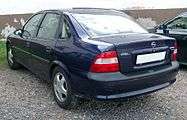 Pre facelift Opel Vectra sedan
Pre facelift Opel Vectra sedan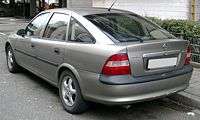 Pre facelift Opel Vectra hatchback
Pre facelift Opel Vectra hatchback.jpg) Facelift Opel Vectra hatchback
Facelift Opel Vectra hatchback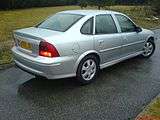 Facelift Opel Vectra sedan
Facelift Opel Vectra sedan Facelift Opel Vectra station wagon
Facelift Opel Vectra station wagon.jpg) Pre facelift Vauxhall Vectra
Pre facelift Vauxhall Vectra.jpg) Facelift Vauxhall Vectra hatchback
Facelift Vauxhall Vectra hatchback_CD_sedan_(2015-05-29).jpg) Holden Vectra sedan (JR)
Holden Vectra sedan (JR)_CD_hatchback_(15912013267).jpg) Holden Vectra hatchback (JS)
Holden Vectra hatchback (JS)_CD_2.2_hatchback_(22543845464).jpg) Holden Vectra hatchback (JS II)
Holden Vectra hatchback (JS II).jpg) Chevrolet Vectra
Chevrolet Vectra
Vectra C (2002–2008)
| Vectra C | |
|---|---|
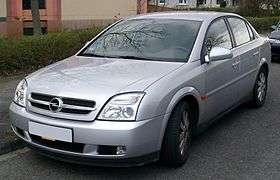 | |
| Overview | |
| Also called |
Chevrolet Vectra Holden Vectra Vauxhall Vectra |
| Production | 2002–2008 |
| Assembly |
Egypt: 6th of October City (GME) England: Ellesmere Port Germany: Rüsselsheim |
| Body and chassis | |
| Body style |
4-door notchback saloon 5-door hatchback 5-door estate |
| Platform | Epsilon platform |
| Related | Opel Signum |
| Powertrain | |
| Engine | |
| Transmission |
6-speed automatic 6-speed manual 5-speed manual Easytronic CVTronic |
| Dimensions | |
| Wheelbase |
2,700 mm (106.3 in) (saloon/hatch) 2,830 millimetres (111 in) (estate) |
| Length |
4,596 mm (180.9 in) (saloon/hatch, pre-facelift) 4,611 mm (181.5 in) (saloon/hatch, post-facelift)[8] 4,822 mm (189.8 in) (estate, pre-facelift) 4,839 mm (190.5 in) (estate, post-facelift) "OPC" versions 31 mm (1.2 in) longer |
| Width | 1,798 mm (70.8 in) |
| Height |
1,460 mm (57.5 in) (saloon/hatch) 1,500 mm (59.1 in) (estate) |
| Curb weight | 1,393 kg (3,071 lb) |
Built on the Epsilon platform, the Opel Vectra C of March 2002 was initially available as a four-door notchback saloon and a five-door hatchback, known as the GTS.[9] A five-door estate was added in 2003.[10] The Vectra C's official debut was at the 2002 Geneva Motor Show. Originally, the Vectra C was due to début with the Saab 9-3 in October 2001, at the Frankfurt Motor Show, but in July 2001, it was announced that delays had forced General Motors to postpone the introduction.[11] The hatchback version premiered in September 2002. The four door notchback saloon version of the Vectra C almost resembled a two-box four door fastback saloon.
The Vectra C was first seen in November 1999, in a copy of Auto Express. At the Frankfurt Motor Show in October 2003, the estate version premièred, which had a slightly longer wheelbase than the hatchback and saloon versions. Sharing the 2,830 millimetres (111 in) wheelbase of the estate, an "executive hatchback" sold under the Opel/Vauxhall Signum nameplate. The Signum, which was based partly on the Vectra C, featured a completely different layout in the rear.[12]
The engine range was substantially modified to account for the increased curb weight of the Vectra C. The 90 kW (121 hp) 1.8 litre Family 1 Ecotec engine was reserved for the base model, with the main petrol engine for the Vectra C, making up the vast bulk of production, being the Ecotec 2.2 litre chain driven unit producing 108 kW (145 hp); along with a new range topping 3.2 litre 54-Degree V6, with 155 kW (208 hp).[13] From June to July 2002, Ed Harris starred in adverts for the Vauxhall Vectra in the United Kingdom.[14] Pierluigi Collina also starred in adverts across Europe for the Vectra, as well as the Signum, in the end of 2005.[15]
In 2003, a 2.0 litre turbocharged Ecotec engine with 129 kW (173 hp) was also notionally offered, but was only produced in tiny numbers, rather it being a main engine for another GM brand, Saab.[16] The 2.2 litre was upgraded in 2004, with the 'Direct' name added to the model line, indicating the new high pressure direct injection update that increased power output to 115 kW (154 hp) with improved emissions.
Diesel power, which had become important for commercial success in Europe,[17] was provided by an Isuzu sourced 3.0 litre DMAX V6 outputting 132 kW (177 hp).
In October 2004, the four cylinder diesel engine was replaced with a Fiat designed 1.9 litre Ecotec CDTI engine capable of producing 89 kW (119 hp) in 8v form and 110 kW (148 hp) in 16v form.[18] Handling was reported to be much better than the previous Vectra.
The Vectra C received a facelift in September 2005, with the début at the Frankfurt Motor Show, and it retained a similar line of engines. However, the power of the 3.0 diesel was increased to 137 kW (184 hp), and the petrol 3.2 litre V6 engine was replaced by an Australian built turbocharged 2.8 litre High Feature V6 unit. This Saab co developed motor could produce 170 kW (228 hp). Opel installed the twin scroll turbo engine in its Signum productline with 185 kW (248 hp) output.
The 185 kW (248 hp) version was available for the Vectra later in 2006. Opel also introduced – for the first time – an OPC version of the Vectra, using the VXR name in the United Kingdom. These high performance variants were only available as hatchbacks and estates. In the United Kingdom the power of the High Feature V6 engine was increased to 188 kW (252 hp), giving a maximum speed approaching 250 km/h (155 mph).
In Australia and New Zealand, the Holden Vectra ZC series was only available as a saloon and hatchback, Holden did not offer the Vectra C estate due to the presence of the Astra and later Holden Viva (Daewoo Lacetti) estates. The Vectra was dropped and replaced by the Holden Epica, a badge engineered Daewoo Tosca early in 2007.[19]
Due to stockpiling of 2005 model Vectras for the Australasian market, there was enough supply of the car for deliveries to last through to 2007. As a result, facelifted Vectra Cs were not sold in those markets.[20] In 2008, the Vectra OPC was available with either six speed manual or six speed automatic transmission (Previous Vectra OPC had manual gearbox only). The 2.8L DOHC V6 turbo engine could generate 206 kW (276 hp).
Sales of the Vectra C in the United Kingdom were not as strong as those of its predecessors. For much of its production life, the original Vectra was the fourth best selling car in the country, but the Vectra C never came higher than tenth in the country's car sales charts, though within its own market sector it held on to second place, behind the Ford Mondeo. In 2007, it finally made the Top 10 of Britain's car sales charts, being the nation's tenth most popular new car with over 50,000 sales, outselling the Ford Mondeo for the first time since 1999.[21]
Also, in January 2007, the estate variant was awarded Estate Car of the Year 2007, by What Car? magazine.[22] While the Vectra C has been sold in Mexico and Chile as the Chevrolet Vectra, it is not marketed in Brazil, where Chevrolet opted to sell the Astra H under the Vectra brand from 2006 to 2011. Both local spec cars are powered by the FlexPower SOHC engine originally introduced in 1982 in the Chevrolet Monza.
Production of the Vectra C and Signum ended in July 2008.
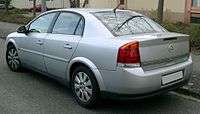 Pre facelift Opel Vectra C Sedan
Pre facelift Opel Vectra C Sedan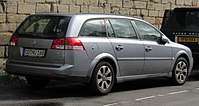 Pre facelift Opel Vectra C Caravan
Pre facelift Opel Vectra C Caravan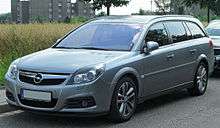 Facelift Opel Vectra C Caravan
Facelift Opel Vectra C Caravan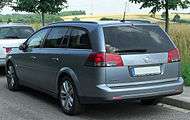 Facelift Opel Vectra C Caravan
Facelift Opel Vectra C Caravan- Facelift Opel Vectra C sedan
 Vauxhall Vectra (United Kingdom; pre facelift)
Vauxhall Vectra (United Kingdom; pre facelift)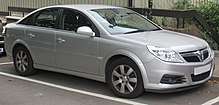 Vauxhall Vectra (United Kingdom; facelift)
Vauxhall Vectra (United Kingdom; facelift)_CDX_hatchback_(23760004760).jpg) Holden Vectra (Australia)
Holden Vectra (Australia).jpg) Chevrolet Vectra (Chile)
Chevrolet Vectra (Chile)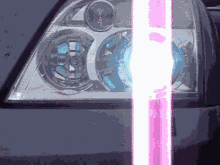 Advanced Front-Lighting System (AFS) headlamps on Vectra
Advanced Front-Lighting System (AFS) headlamps on Vectra
Motorsport
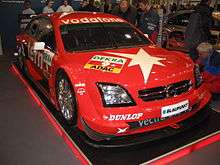
The Vectra was used in several touring car racing series. In the 1990s and early 2000s, the Vectra B Super Touring took part in the British Touring Car Championship, the Asia-Pacific Touring Car Championship, the German Super Tourenwagen Cup, the Australian Super Touring Championship, the Japanese Touring Car Championship, the Italian Superturismo Championship, the French Supertouring Championship and the Swedish Touring Car Championship.
Uwe Alzen was third in Super Tourenwagen Cup in 1997 and 1998 and second in 1999; John Henderson was runner up in the 2000/2001 Australian Super Touring Championship; John Cleland was British Touring Car Champion in 1995 and finished third in 1992 and fourth in 1993 and 1994; Yvan Muller was sixth in the 1999 British Touring Car Championship and fourth in 2000; and Nicklas Karlsson was third in the 2002 Swedish Touring Car Championship.
A prototype Vectra B was built to the BTC Touring specifications in 2003 by Triple Eight Race Engineering, with the view to using it in the 2004 BTCC, but it was never raced, despite being shown publicly at the 2004 Birmingham Motor Show as the 'Vectra Diesel Concept'.[23]
After being replaced by the Astra H in the British Touring Car Championship, the Vauxhall Vectra was introduced in 2007. Fabrizio Giovanardi was champion in 2007 and 2008. VX Racing competed in the 2009 season with three Vectras, driven by Giovanardi, Matt Neal and Andrew Jordan.
The Vectra has been used as a silhouette racing car: in the Stock Car Brasil in 2000 to 2003 (it was the champion for four seasons) and 2009, in the Argentine Top Race V6 since 2005 (Guillermo Ortelli was 2005 champion), and in the Deutsche Tourenwagen Masters in 2004 and 2005 with little success.
References
- ↑ Satyam. "Welcome to GMArabia.com". Gmegypt.com. Archived from the original on 9 August 2010. Retrieved 2 October 2010.
- ↑ Aucock, Richard (August 2006). "Vauxhall Vectra". Auto Express. Dennis Publishing. Retrieved 14 March 2009.
- ↑ "The loss of Luton". Car Magazine. February 2001. p. 13.
- ↑ Why General Motors is keeping its faith in Vauxhall's Luton plant, Autocar, 25 August 2014
- ↑ "THIS WEEK: Vauxhall is launching the estate version of its Vectra ..." www.campaignlive.co.uk. 7 November 1996. Retrieved 7 December 2017.
- ↑ Business Review Weekly: BRW, Volume 20, Issues 1-6, page 19
- ↑ "The 13 Worst Cars of the Last 20 Years". Top Gear magazine. 31 October 2013. Retrieved 12 October 2014.
- ↑ Vauxhall Vectra owners' Manual July 2007 ref TS 1557-A-08
- ↑ "New Holden Vectra goes up-market". WebWombat. Retrieved 7 January 2008.
- ↑ "Vauxhall Vectra Estate (2003 – To Date)". Yahoo!. Retrieved 7 January 2008.
- ↑ "Page Not Found - Autotrader". AutoTrader.com. Archived from the original on 18 May 2015. Retrieved 23 April 2017.
- ↑ "Opel Vectra and Signum Facelifts". Automotriz. Archived from the original on 6 March 2008. Retrieved 7 January 2008.
- ↑ "Opel Vectra GTS". Babez.de. Retrieved 7 January 2008.
- ↑ "Ad of the Week: Vauxhall puts Vectra on trial". www.telegraph.co.uk. 18 June 2002. Retrieved 21 September 2017.
- ↑ "Referee Collina 'takes control' in Vauxhall TV and print campaign". www.campaignlive.co.uk. 23 September 2005. Retrieved 9 November 2017.
- ↑ "New Opel Signum: Versatile, Innovative, Unique". Black Falcon Media Group Oy. Retrieved 7 January 2008.
- ↑ Christine, Tierney; Weich, David (3 May 2003). "The Smell of Diesel Is Back in the Air". McGraw-Hill. Retrieved 7 January 2008.
- ↑ "Vauxhall Vectra CDTI 150". Khoo Systems. 17 October 2004. Retrieved 10 January 2008.
- ↑ Newton, Bruce (June 2007). "Sneer Miss". Wheels. pp. 104–108.
- ↑ Yan, Jack (26 May 2007). "Holden Epica arrives in New Zealand (God help us)". Jack Yan & Associates. Retrieved 29 April 2008.
- ↑ Finlay, David (8 January 2008). "UK Motor Industry 2007". PDRonline. Archived from the original on 16 January 2008. Retrieved 10 January 2008.
- ↑ "Car of the Year 2007 – Estate car". What Car?. 19 January 2007. Retrieved 10 January 2008.
- ↑ Autosport magazine feature 25 January 2007 'Tin-Tops That Never Raced'
External links
| Wikimedia Commons has media related to |
- www.Vauxhall.co.uk – Vauxhall UK
« previous — Opel car timeline, 1980s–present | |||||||||||||||||||||||||||||||||||||||
|---|---|---|---|---|---|---|---|---|---|---|---|---|---|---|---|---|---|---|---|---|---|---|---|---|---|---|---|---|---|---|---|---|---|---|---|---|---|---|---|
| Type | 1980s | 1990s | 2000s | 2010s | |||||||||||||||||||||||||||||||||||
| 0 | 1 | 2 | 3 | 4 | 5 | 6 | 7 | 8 | 9 | 0 | 1 | 2 | 3 | 4 | 5 | 6 | 7 | 8 | 9 | 0 | 1 | 2 | 3 | 4 | 5 | 6 | 7 | 8 | 9 | 0 | 1 | 2 | 3 | 4 | 5 | 6 | 7 | 8 | |
| City car | Agila A | Agila B | Karl | ||||||||||||||||||||||||||||||||||||
| Adam | |||||||||||||||||||||||||||||||||||||||
| Supermini | Corsa A | Corsa B | Corsa C | Corsa D | Corsa E | ||||||||||||||||||||||||||||||||||
| Chevette | |||||||||||||||||||||||||||||||||||||||
| Small family car | Kadett D | Kadett E | Astra F | Astra G | Astra H | Astra J | Astra K | ||||||||||||||||||||||||||||||||
| Ampera | Ampera-e | ||||||||||||||||||||||||||||||||||||||
| Large family car | Ascona B | Ascona C | Vectra A | Vectra B | Vectra C / Signum | Insignia A | Insignia B | ||||||||||||||||||||||||||||||||
| Executive car | Rekord E / Commodore C | Omega A | Omega B | ||||||||||||||||||||||||||||||||||||
| Luxury car | Senator A | Senator B | |||||||||||||||||||||||||||||||||||||
| Coupé | Tigra A | ||||||||||||||||||||||||||||||||||||||
| Manta B | Calibra | ||||||||||||||||||||||||||||||||||||||
| Monza | |||||||||||||||||||||||||||||||||||||||
| Convertible | Tigra TwinTop B | Cascada | |||||||||||||||||||||||||||||||||||||
| Sports car Roadster |
Speedster | GT (Roadster) | |||||||||||||||||||||||||||||||||||||
| Mini MPV | Meriva A | Crossland X | |||||||||||||||||||||||||||||||||||||
| Compact MPV | Meriva B | ||||||||||||||||||||||||||||||||||||||
| Zafira A | Zafira B | ||||||||||||||||||||||||||||||||||||||
| Large MPV | Sintra | Zafira Tourer C | |||||||||||||||||||||||||||||||||||||
| Mini SUV | Mokka | ||||||||||||||||||||||||||||||||||||||
| Compact SUV | Frontera A | Frontera B | Antara | Grandland X | |||||||||||||||||||||||||||||||||||
| Mid-size SUV | Monterey | ||||||||||||||||||||||||||||||||||||||
| Pick-up | Campo | ||||||||||||||||||||||||||||||||||||||
| LAV | Kadett Combo | Combo B | Combo C | Combo D | Combo E | ||||||||||||||||||||||||||||||||||
| LCV | Bedford Blitz | Arena | Vivaro A | Vivaro B | |||||||||||||||||||||||||||||||||||
| Movano A | Movano B | ||||||||||||||||||||||||||||||||||||||
Holden, a marque of General Motors, automobile timeline, 1948–present |
|---|
| List of Holden vehicles † HQ–WB Statesmans not marketed under the "Holden" brand, but rather the separate "Statesman" brand. |
